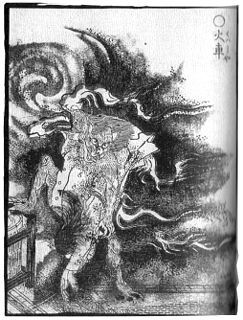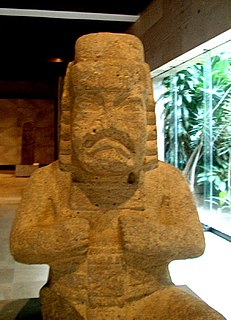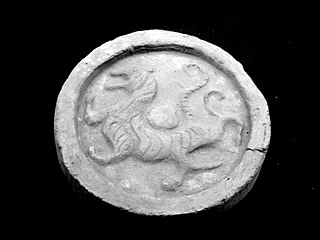 W
WThe bakeneko is a type of Japanese yōkai, or supernatural creature. It is often confused with the nekomata, another cat-like yōkai. The distinction between them is often ambiguous, but the largest difference is that the Nekomata has two tails, while the Bakeneko has only one.
 W
WThe ball-tailed cat is a fearsome critter of North American folklore most commonly described as having similar traits to that of a mountain lion, except with an exceedingly long tail to which there is affixed a solid, bulbous mass for striking its prey. Tales of ball-tailed cats were common among woodsmen during the turn of the 20th century and many variations exist; two of the more prominent variants are the digmaul and the silvercat. The latter is distinguishable for not only having a smooth-sided ball for knocking wayfarers unconscious, but in addition a spiked-side for piercing and grappling its victims.
 W
WBastet or Bast was a goddess of ancient Egyptian religion, worshiped as early as the Second Dynasty. Her name also is rendered as B'sst, Baast, Ubaste, and Baset. In ancient Greek religion, she was known as Ailuros.
 W
WThe cactus cat is a legendary fearsome critter of the American Southwest.
 W
WThe Cat Sìth or Cat Sidhe is a fairy creature from Celtic mythology, said to resemble a large black cat with a white spot on its chest. Legend has it that the spectral cat haunts the Scottish Highlands. The legends surrounding this creature are more common in Scottish folklore, but a few occur in Irish. Some common folklore suggested that the Cat Sìth was not a fairy, but a witch that could transform into a cat nine times.
 W
WThe representation of jaguars in Mesoamerican cultures has a long history, with iconographic examples dating back to at least the mid-Formative period of Mesoamerican chronology. The jaguar is an animal with a prominent association and appearance in the cultures and belief systems of pre-Columbian Mesoamerican societies in the New World, similar to the lion and tiger in the Old World. Quick, agile, and powerful enough to take down the largest prey in the jungle, the jaguar is one of the biggest felids in Central or North America, and one of the most efficient and aggressive predators. Endowed with a spotted coat and well adapted for the jungle, hunting either in the trees or water, making it one of the few felines tolerant of water, the jaguar was, and remains, revered among the indigenous Americans who live closely with the jaguar.
 W
WThe kasha is a Japanese yōkai that steals the corpses of those who have died as a result of accumulating evil deeds.
 W
WThe Kilkenny cats are a fabled pair of cats from County Kilkenny in Ireland, who fought each other so ferociously that only their tails remained at the end of the battle. Often the absurd implication is that they have eaten each other. "P. M'Teague" (1840). Dickens, Charles; Ainsworth, William Harrison; Smith, Albert (eds.). "Watty Flaherty; Chapter I". Bentley's Miscellany. London: Richard Bentley. VII: 391–404: 395. Retrieved 8 November 2019. A Kilkenny cat!" exclaimed Mr. O'Dowd. "Why they eat one another up! </ref> In the nineteenth century the Kilkenny cats were a common simile for any conflict likely to ruin both combatants. Kilkenny cat is also used more generally for a fierce fighter or quarrelsome person. These senses are now rather dated. In the later twentieth century the motif was reclaimed by Kilkenny people as a positive symbol of tenacity and fighting spirit, and "the Cats" is the county nickname for the Kilkenny hurling team. The original story is attested from 1807 as a simple joke or Irish bull; some early versions are set elsewhere than Kilkenny. Nevertheless, theories have been offered seeking a historical basis for the story's setting.
 W
WThe King of the Cats is a folk tale from the British Isles. The earliest known example is found in Beware the Cat, written by William Baldwin in 1553, though it is related to the first century story of "The Death of Pan". Other notable versions include one in a letter written by Thomas Lyttelton, 2nd Baron Lyttelton, first published in 1782, M. G. Lewis told the story to Percy Bysshe Shelley in 1816, and a version was adapted by Joseph Jacobs from several sources, including one collected by Charlotte S. Burne. Walter Scott reported that it was a well known nursery tale in the Scottish Highlands in the eighteenth century. It can be categorised as a "death of an elf " tale: Aarne–Thompson–Uther type 113A, or Christiansen migratory legend type 6070B.
 W
WThe lynx, a type of wildcat, has a prominent role in Greek, Norse, and North American mythology. It is considered an elusive and mysterious creature, known in some American Indian traditions as a 'keeper of secrets'. It is also believed to have supernatural eyesight, capable of seeing even through solid objects. As a result, it often symbolises the unravelling of hidden truths, and the psychic power of clairvoyance.
 W
WMafdet was a goddess in the ancient Egyptian religion. She was often depicted wearing a skin of a cheetah, and protected against the bite of snakes and scorpions. She is part of the ancient Egyptian deities during the First Dynasty of Egypt. She was prominent during the reign of pharaoh Den whose image appears on stone vessel fragments from his tomb and is mentioned in a dedicatory entry in the Palermo Stone. Mafdet was the deification of legal justice, or possibly of capital punishment. She was associated with the protection of the king's chambers and other sacred places, and with protection against venomous animals, which were seen as transgressors against Maat. In the Pyramid Texts of the Old Kingdom of Egypt, she is mentioned as protecting the sun god Ra from venomous snakes.
 W
WNekomata are a kind of cat yōkai described in Chinese and then Japanese folklore, classical kaidan, essays, etc. There are two very different types: those that live in the mountains and domestic cats that have grown old and transformed. Nekomata are often confused with Bakeneko.
 W
WA Panther is a creature in ancient legend that resembles a big cat with a multicoloured hide.
 W
WA pard is a legendary animal that is listed in Medieval bestiaries and in Pliny the Elder's book Natural History. Over the years, there have been many different depictions of the creature including some adaptations with and without manes and some in later years with shorter tails. However, one consistent representation shows them as large felines often with spots.
 W
WThe Indian leopard is a leopard subspecies widely distributed on the Indian subcontinent. The species Panthera pardus is listed as Vulnerable on the IUCN Red List because populations have declined following habitat loss and fragmentation, poaching for the illegal trade of skins and body parts, and persecution due to conflict situations.
 W
WIn Aztec mythology, Tepēyōllōtl Nahuatl pronunciation: [tepeːˈju˕ːɬːu˕ːtɬ] was the god of earthquakes, echoes and jaguars. He is the god of the Eighth Hour of the Night, and is depicted as a jaguar leaping towards the sun. In the calendar, Tepeyollotl rules over both the third day, Calli (house), and the third trecena, 1-Mazatl (deer). He is the eighth Lord of the Night.
 W
WThe Tiger (寅) is the third of the 12-year cycle of animals which appear in the Chinese zodiac related to the Chinese calendar. The Year of the Tiger is associated with the Earthly Branch symbol 寅.
 W
WAn underwater panther, called Mishipeshu or Mishibijiw in Ojibwe, is one of the most important of several mythological water beings among many indigenous peoples of the Northeastern Woodlands and Great Lakes region, particularly among the Anishinaabe.
 W
WThe Wampus cat is a cat-like creature in American folklore that varies widely in appearance, ranging from frightful to comical, depending on region.
 W
WA werecat is an analogy to "werewolf" for a feline therianthropic creature.
 W
WThe were-jaguar was both an Olmec motif and a supernatural entity, perhaps a deity.
 W
WThe White Tiger is one of the Four Symbols of the Chinese constellations. It is sometimes called the White Tiger of the West, and is known as Baihu in Chinese, Byakko in Japanese, Baekho in Korean, and Bạch Hổ in Vietnamese. It represents the west in terms of direction and the autumn season.